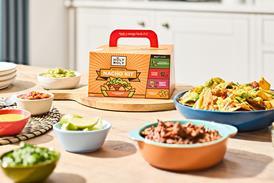Retailers and suppliers are certainly talking a good talk. But can they really walk five billion calories off Britain’s daily diet?
Someone at the Department of Healthhas a warped sense of humour. Why else wait until just before the jubilee weekend - when the nation would gorge itself on cupcakes and scones - to release details of how the grocery trade would help Brits control their calories?
The DH revealed the action supermarkets, caterers and food & drink suppliers are taking to fulfil the pledge they made to health secretary Andrew Lansley in March to help cut five billion calories from the UKs daily diet. It’s a big, fat ask - and some industry watchers have raised concerns about how effective it may be.
Retailers
At their core, the retailers various pledges are understandably similar: to support the development of calorie-controlled options through reformulation and portion sizing, flag up nutritional information on pack and educate consumers and staff about healthy choices.
For Morrisons, much activity centres on the healthy NuMe brand it started rolling out last month. This will feature icons to indicate calorie content and carry WeightWatchers ProPoints on pack - something Waitrose is also to introduce on its LoveLife healthy range.
Most supermarkets will highlight lower-calorie options through on-pack graphics, with Sainsbury’s stating that it will roll out ‘calorie flashes’ on Be Good to Yourself products that contain 30% fewer calories than the standard own-label equivalent, and Tesco flagging up lower-calorie options with ‘Green Ping’ labels. Asda, meanwhile, will roll out traffic light and GDA labelling to all its processed products.
Some retailers have also described how marketing activity will promote lower-calorie options. Sainsbury’s says at least a third of its product promotions will be on healthier choices, while M&S has promised to run at least one health-led marketing campaign a year and will ensure healthier foods are promoted throughout the year.
While welcoming such activity, Dr Martin Caraher, professor of food and health policy at City University, said retailers should have gone further. “I would have liked to have seen more in the way of in-house marketing activity from the retailers - they are a powerful force and there is a real opportunity there to influence consumers.” This could have stretched, suggest industry observers, to a greater commitment to encouraging consumption of fresh fruit and vegetables through marketing and promotional activity.
Some supermarkets, including Waitrose, have also referred to working with suppliers to develop techniques that reduce calories. Tesco, meanwhile, is to establish a product improvement code of practice to help technical managers and suppliers reduce the calorie content of products, which it will support with training programmes.
Suppliers
The suppliers have each submitted a range of pledges - and they are more of a mixed bag than the retailers’, with activity varying widely between manufacturers.
This, suggests Giles Quick, director at retail analysts Kantar WorldPanel, highlights a fundamental flaw in the government’s approach to the issue.
“Individually, the various pledges are perfectly reasonable, but taken collectively it is very unimpressive,” he says. “The responsibility for this lays at the government’s door for failing to take a more prescriptive approach to the issue.”
Caraher also feels central guidance was needed - or even common front-of-pack labelling. “The problem with voluntary agreements is they leave the power in the hands of the retailers or producers. Some standardisation across the issues and messages would be good.”
A prescriptive approach would not work for calorie reduction in the way it had for salt, says Dr Susan Jebb, chair of the Public Health Responsibility Deal Food Network. “It is early days and we need to see what works. If, over time, particular ideas are making a difference, there will be an opportunity to encourage other companies to do something similar.”
The confectionery suppliers show how varied the ideas can be, with Mars stating it will cut calories and reduce portion size to bring all its chocolate products to 250 calories or less per portion by 2013 (see The Grocer 2 June 2012, p6). Kraft says its Cadbury business will also develop lower-calorie formats, and is looking to extend its use of resealable packaging.
Nestlé, however, suggests that it would “encourage the sharing of relevant confectionery products”. The supplier was more robust on its wider portfolio, stating that it would increase the number of products containing no more than 10% of the GDA of calories per serving and expand its 99kcal chocolate biscuit range.
UBUK pledged to expand its Go Ahead! healthier biscuits range and trial calorie-controlled portion packs of core ranges such as McVitie’s Digestives and Chocolate Hobnobs.
Walkers owner PepsiCo repeated the promise it made two years ago to introduce a 160-calorie cap on single-serve savoury snacks by 2015. Rival Coca-Cola will increase its advertising budget for no-calorie, zero-sugar colas and is investing £15m in reducing the calorie content of leading brands - but not Coca-Cola itself - by 30% by 2014.
Coca-Cola’s pledges - like those of so many retailers and suppliers - are impressive. But ask observers whether the sum activity will knock five billion calories off Britain’s daily intake and the message is all too clear. Fat chance.
Below are highlights of the calorie reduction pledges made by retailers and suppliers under the Responsibility Deal. Here’s a full list of all signees and their pledges.
Asda
- Roll out front-of-pack labelling system (traffic lights and GDAs) to all its (processed) categories
- Support reduced-calorie range containing 30% fewer calories than their standard equivalent
- Develop a range of portion-controlled options across bakery and snacking
Marks & Spencer
- Offer calorie-controlled portion sizes of treats, snacks and desserts
- Clear calorie labelling on packaged food and continue extension of calorie labelling to unpackaged food such as hospitality and instore bakery
- Offer a range of calorie-controlled options across prepared meals, sandwiches and salads
- Clearly highlight healthier choices across our range of food
- Run at least one health-led marketing campaign per year
- Ensure healthier foods are promoted throughout the year and that there is always a healthier choice available from Dine In
Morrisons
- Replace existing Eat Smart range with new health and wellness brand NuMe, rolling out throughout 2012
- NuMe brand design will feature clear nutritional labelling with bold calorie and nutrition icons to communicate calorie content per serving, and Weight Watchers ProPoints on pack
- Increase core distribution of healthier own brand range, with minimum of 160 lines across 85% of our stores
- Include popular dishes in convenient formats that offer a calorie-controlled option, including chilled and frozen ready meals, frozen desserts and pizza.
Sainsbury’s
- Reduce the proportion of red rated Multiple Traffic Lights – including calories that are red rated - on own-label products
- Ensure that at least a third of food and drink product promotions are on healthier choices, including lower-calorie food and drinks
- Roll out “calorie flashes” on Be Good To Yourself products which contain 30% less calories than the standard own-label equivalent
Tesco
- Review and pursue opportunities for reducing calories through product improvement
- Reduce the number of calories sold in its soft drinks by over 150 million in 2012
- Launch a new Product Improvement Code of Practice to provide guidance to technical managers and suppliers on the opportunities to reduce the calorie content of products. This will be supported by training programmes
- Launch a new range of healthy-eating, nutritionally balanced convenience meals
- Increase Goodness range of healthy meals, sauces and snacks for children
Waitrose
- Target calorie reductions within product development plan for 2012 through reformulation of processed products to decrease energy density and/or reduce portion size
- Work with key suppliers to develop and share techniques that help reduce calories
- Continue to promote and develop LOVE Life range of products that have defined nutritional criteria, including calories per meal/eating occasion
- Front of pack claims highlighting nutritional benefits will appear on more products to help customers make healthier choices
- Introduce Weight Watchers Pro Points on LOVE Life You Count packs later this year
- Introduce more healthy options in our coffee shops and cafes
Coca-Cola
- Cut average calories per litre in its sparkling soft drinks by 5%
- Invest £15m in reformulating leading soft drinks brands – but not Coca-Cola - by 2014 with aim of cutting calorie content of these drinks by at least 30%
- Increase marketing budget for no-calorie, zero-sugar colas by 25% from 2011 level by end of 2014
Kerry Foods
- Aim to reduce calories by an average of 5% on key brands by 2014
- Majority of NPD in branded dairy portfolio will be reduced fat, with fewer calories compared with standard equivalent products
- Encourage consumers to choose healthier options by supporting and promoting its healthier option brands such as LowLow cheese
Kraft Foods
- Offer and promote lower-fat and light versions of brands such as Philadelphia and Dairylea
- Introduce re-sealable packaging on many chocolate brands, including Cadbury Dairy Milk, and continue R&D in lower-calorie formats such as the aerated Cadbury Dairy milk Bubbly
Mars (UK)
- Renovate products to reduce levels of satfat and decrease calories per serving
- Reduce calories per portion through the reduction of portion sizes
- Providing wide range of pack sizes and formats
- Make all chocolate products no more than 250 calories per portion by 2013
- Introduce smaller bars in impulse range and reduce multi-pack sizes from five bars per pack to four
Nestlé UK
- Continue to reduce calories where feasible and launch products offering lower or low-calorie choices and with lower calorie levels than equivalent products
- Expand 99kcal chocolate biscuit range
- Launch more than one third of new products in 2012 in a smaller portion than standard products
- Increase number of products containing no more than 10% calorie GDA per serving
- Recommend use of semi-skimmed and skimmed milk for preparation of its products
- Encourage sharing of relevant confectionery products
PepsiCo UK & Ireland
- PepsiCo has re-iterated the pledge it made in 2010 to introduce a voluntary calorie cap of 160 calories across single serve savoury snacks without positive nutrition by 2015
- Further pledges to follow
Premier Foods
- Work to reduce calories across one third of its branded portfolio by 2014
- At least 30% of new products launched each year will provide lower-calorie choices
- Reformulate existing products to reduce sugar, fat and saturated fat levels and provide a range of different portion sizes
- Already rolled out calorie-cutting recipe reformulations during 2012, including fat and saturated fat reductions to its Hovis Soft White range
- Its new Sharwood’s Tikka cooking sauces have an average of 7.5% fewer calories, 35% less saturated fat and 58% less sugar than its Original Tikka sauce
- New Ambrosia rice pot range has replaced the previous 150g and 135g pots with a wider selection and smaller, lower-calorie choices.
Unilever
- By 2014, 100% of our children’s ice creams will contain 110 calories or fewer per portion. We will also look at calorie reduction in other brands
- Continue to look at innovations that provide healthier options for the consumer
United Biscuits (UK)
- Launch at least one new savoury bagged snack in 2012 that is baked and not fried, and will contain fewer calories than the average calories per bag of potato crisps of the same weight
- Carry out a market test of calorie-controlled portion packs of some of its core range of biscuits, e.g. McVitie’s Digestives and Chocolate Hobnobs
- Expand range of products in Go Ahead! healthier biscuits brand



















No comments yet